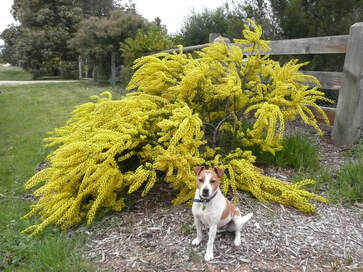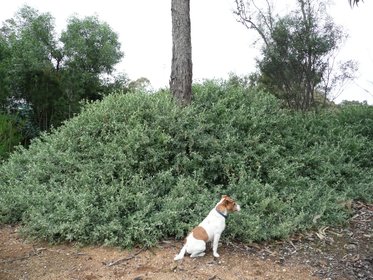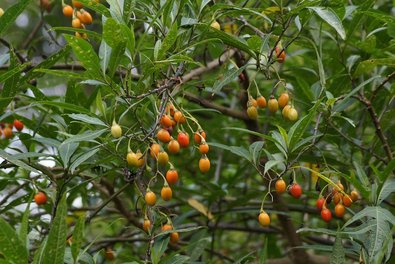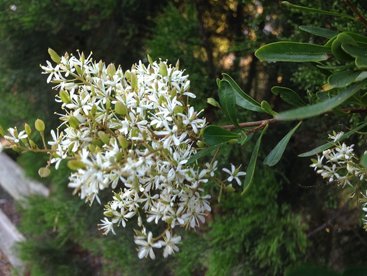Making a list of plants for revegetation
Making a list of plants for revegetation
 The diverse EVC's of Geelong, Victoria. Any location in Victoria can be selected on the dse website to the left. The different colours represent the different ecologys and vegetation prior to 1750. A legend translates the colours into EVC names.
The diverse EVC's of Geelong, Victoria. Any location in Victoria can be selected on the dse website to the left. The different colours represent the different ecologys and vegetation prior to 1750. A legend translates the colours into EVC names.
Making a list of suitable plant species might seem daunting but be reassured that there is lots of support out there to get you started.
If you need some quick suggestions, scroll down to the link under the heading 'The Greater City of Geelong' for some ready made lists for localities in the Geelong region.
I'm happy to answer questions about suitable plant species by email. For more detailed design advice, a site visit and plant lists, I'm available for consultation. [email protected]
EVC's
Before you start developing a plant list, it will help to know about Ecological Vegetation Classes or EVC's.
This is a classification system for all the different ecologies found in Victoria.
Ecology comes from the Greek word for home which is 'oikos'. In natural areas in Victoria we have a huge variety of different ecologies or homes in which native plants and animals live.
These homes can be;
- beside a creek where it is moist and protected,
- on the open plains where it is exposed,
- in the desert where it is dry with extremes of super hot days and freezing cold night temperatures or
- on the top of a mountain range where it is cool, moist with very little top soil.
The plants and animals that have adapted to these different ecologies are unique.
The EVC classification system organises all this diverse and unique information about these homes and the plants that live there to help us decide which plants are suitable to plant where.
You can determine your farm's various EVC's on the biodiversity interactive map by clicking - mapshare2.dse.vic.gov.au/MapShare2EXT/imf.jsp?site=bim
Read below to discover how to use this interactive map under the heading 'Internet sites you can visit'
If you need some quick suggestions, scroll down to the link under the heading 'The Greater City of Geelong' for some ready made lists for localities in the Geelong region.
I'm happy to answer questions about suitable plant species by email. For more detailed design advice, a site visit and plant lists, I'm available for consultation. [email protected]
EVC's
Before you start developing a plant list, it will help to know about Ecological Vegetation Classes or EVC's.
This is a classification system for all the different ecologies found in Victoria.
Ecology comes from the Greek word for home which is 'oikos'. In natural areas in Victoria we have a huge variety of different ecologies or homes in which native plants and animals live.
These homes can be;
- beside a creek where it is moist and protected,
- on the open plains where it is exposed,
- in the desert where it is dry with extremes of super hot days and freezing cold night temperatures or
- on the top of a mountain range where it is cool, moist with very little top soil.
The plants and animals that have adapted to these different ecologies are unique.
The EVC classification system organises all this diverse and unique information about these homes and the plants that live there to help us decide which plants are suitable to plant where.
You can determine your farm's various EVC's on the biodiversity interactive map by clicking - mapshare2.dse.vic.gov.au/MapShare2EXT/imf.jsp?site=bim
Read below to discover how to use this interactive map under the heading 'Internet sites you can visit'
 The beautiful Gold Dust Wattle is a member of the Mimosa Family.
The beautiful Gold Dust Wattle is a member of the Mimosa Family.
Local People you can ask:
- A neighbour who has planted trees. You'd be surprised how good local knowledge can be and it could lead to support in other ways such as finding the Nurseries to go to, the Landcare groups in your locality and the Council officers that will help
- Your local nursery. Nursery's worth their salt will offer free advice because its also good for their business. They may also offer site visits and a design service for a reasonable fee
- Landcare. If you don't know about Landcare then I would recommend it very highly. It has done an enormous amount of the heavy lifting to put trees back on farms. Landcare has provided free advice, equipment and networking over the past 30 years. They have regular meetings with interesting guest speakers and they're always pleased to meet new people with an interest in the local environment.
Elissa Ashton-Smith is the Geelong Landcare Coordinator. She is an excellent resource person if you are living in the Geelong Region - [email protected]
In a broader context the Victorian Landcare Council has an informative website and an amazing facebook page. - www.facebook.com/victorianlandcarecouncil/ and www.vlc.org.au/
 The dense grey leafed Fragrant Salt-bush is a member of the Amaranth Family.
The dense grey leafed Fragrant Salt-bush is a member of the Amaranth Family.
- Friends of the local bush. The Friends organisation supports groups of community volunteers who want to protect and enhance their local reserves. The Victorian National Parks Association will give you contact details of local Friends groups in your area and the group members are very likely to know the local plants - vnpa.org.au/page/about-us/what-we-do
- Local Council will have an officer whose job it is to manage Council owned reserves. They will have the title of 'Natural Resources Officer' or 'Environment Officer' and they are paid to help you and answer your questions.
 The Drooping Sheoak is a member of the Casuarina Family.
The Drooping Sheoak is a member of the Casuarina Family.
- Parks Victoria manage a lot of the parks and reserves in Victoria. Their website is full of information about visiting parks to make your experience safe and enjoyable. The Park Rangers are dedicated people who really love what they do and are keen to help. Their website is worth a visit if you want a plant list or you're planning a park visit - parkweb.vic.gov.au
In the Geelong region the Parks office is in the You Yangs National Park. You can speak to a Park Ranger on 5282 3356 or at Serendip Wildlife Sancturary on 5283 8000 - If you want to improve your own knowledge in a formal sense then The Gordon TAFE in Geelong offers a Certificates and a Diploma of Conservation and Land Management which has a 'Plant and Animal Identification' unit. The lecturers at the TAFE colleges are also very knowledgeable, as are many of their students. Follow this link to find out more. www.thegordon.edu.au/courses/all-courses/ahc51110-diploma-of-conservation-and-land-manageme
- Federation University, Ballarat also offers a 'Bachelor of environment and conservation science'
The subjects you'll explore include ecology and wildlife, water and climate, landscape management and restoration and they have a strong focus on the Australian environment.
 The hardy Tree Violet is a member of the Violet Family.
The hardy Tree Violet is a member of the Violet Family.
Internet sites you can visit:
- The Greater City of Geelong have a map of vegetation zones for the districts around Geelong on their website and plants list for each zone. Click on this link to take you there; www.geelongaustralia.com.au/indigenousplants/article/item/8ce589e1bce0fe8.aspx
- Catchment Management Authority in Victoria are also an excellent resource. They have lots of knowledgable staff who are involved in putting indigenous plants back on our waterways. They also provide grants for projects so they are an important contact. To find your local CMA go to www.delwp.vic.gov.au/water/governing-water-resources/catchment-management-authorities and scroll down to 'Your local CMA' and click to another informative website about your area.
 The Correa/Native Fuchsia is a member of the Citrus Family
The Correa/Native Fuchsia is a member of the Citrus Family
- Department of Environment, Lands, Water and Planning (DELWP) are also well resourced with knowledgeable people. To find your local office and to get some help click delwp.vic.gov.au/environment-and-wildlife
Once it has opened at the map of Victoria, click on the map to zoom to where you live. Repeat this or use the zoom tool on the top bar, until you have the location and the scale of map that you want.
Now on the right side bar click on the 'Ecological Vegetation Class' folder; then click the pre 1750 folder. The map will show lots of colour and fancy patterns that represent different EVC's. Now click on 'Legend' on the top bar so that you can interpret the map.
One more step will give you a map to print off and refer to. Click on the pdf icon on the right of the top bar and follow the prompts. You can even put your name on the map to impress friends. A map and legend will come onto your screen which you can print off.
 The Kangaroo Apple is a member of the Tomato Family
The Kangaroo Apple is a member of the Tomato Family
- For the Benchmark plant lists of your EVC go to,
Then pick your bioregion from the map of Victoria and scroll down to the bioregion table and click.
Here you will get a short description of your bioregion and a pdf file of the different EVC plant lists for your bioregion to click on.
These are lists of plants that are commonly found in your EVC. They are a guide and not a full list.
 The remarkable Sweet Bursaria is a member of the Pittosporum Family
The remarkable Sweet Bursaria is a member of the Pittosporum Family
- To expand the list you can go to VicVeg Online www.vicveg.net.au/vvCommunities2.aspx
Now you should have an extensive plant list for your EVC that nurseries can propagate (There is also a broader list of plants, some of which are very difficult to propagate, but useful for identifying any remnant plants on your property)
 The Snowy Mintbush is a member of the Mint Family
The Snowy Mintbush is a member of the Mint Family
- Seeding Victoria is the seed bank for indigenous seed for the central Victoria. You can buy seed directly from them if you are planning to direct seed or propagate your own plants. Click here to have a look at their website www.seedbank.com.au/
- Victorian Native Seed is a private supplier of rare and native seed. There website is full of well researched information. http://www.victoriannativeseed.com.au/
 The Grey Everlasting is a member of the Daisy Family
The Grey Everlasting is a member of the Daisy Family
- Vic Flora - Flora of Victoria, A Royal Botanic Gardens site, have an excellent website that offers descriptions of plants and photos. You can narrow your search through various filters. vicflora.rbg.vic.gov.au/flora/search
- The Australian National Botanic Gardens website allows you to search for pictures and descriptions if you know the genus and species name of a plant. Click here to have a look www.anbg.gov.au/photo/genus-photo-search.html
- The Australian Plant Society are a very active and well informed group of volunteers that publish excellent reference books and provide practical information on their website about plants, what to plant where, garden design and lots more. Click here to explore anpsa.org.au/index.html . There are branches in every state and local groups as well. For example the Victorian branch have their own excellent website: apsvic.org.au/
- Google maps is also an excellent resource to have a birds-eye view of your property. Did you know that you can measure distances and areas by using the 'right click' button on your mouse? Click on two points across a paddock to get the distance. Go round the paddock clicking to define the shape and do your last click where you started to complete the polygon and get the area.
